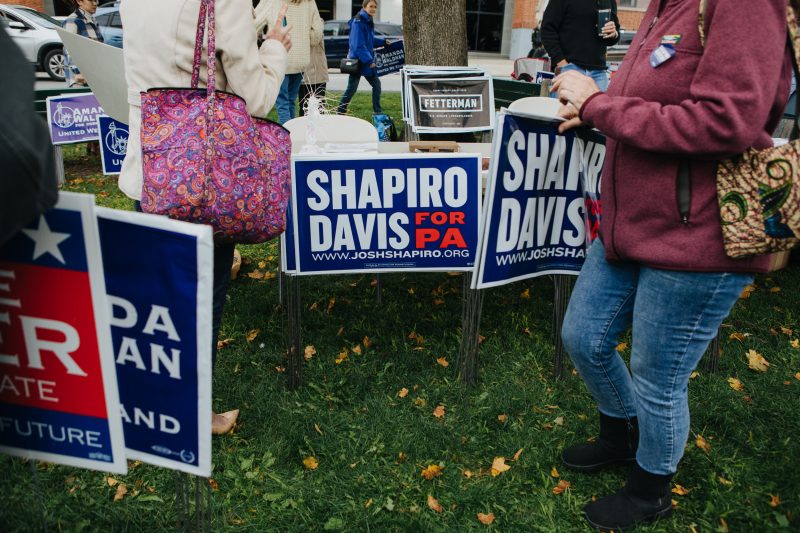Pennsylvania Gov. Josh Shapiro (D) won election in 2022 by a wide margin. In a state that President Biden won by a bit over a percentage point in 2020 and in which Sen. John Fetterman (D) triumphed in the midterms by a bit under five points, Shapiro crushed Republican Doug Mastriano by double digits. It was a rout in a state where routs have been few and far between in recent years.
Not that it wasn’t seen coming. Shapiro led by wide margins in pre-election polls, including from Republican-leaning outlets. The Republican Party declined to weigh in heavily on Mastriano’s behalf.
And yet Mastriano thought he would win. Why? His lawn-sign advantage.
“I’d go to these rallies and people would say, ‘We’ve never seen this,’” Mastriano said in a recent interview with Politico. “In Josh Shapiro’s home county the night before the election, I had over 1,000 people — we stopped counting at 1,000. I saw no Shapiro signs in his own county. Here I am in Montgomery County the night before the election, I’m like, we got this. The rally was just electric.”
Again, Mastriano did not “got this.”
There are several ways in which this metric makes little sense for a sophisticated political observer to consider. Lawn signs are not only not votes (obviously), they neither have a significant effect on election outcomes nor do they necessarily reflect real support. If you’ve ever driven around an even remotely spacious area near an election, you’ve seen plenty of lawn signs dotting highways and street corners, places few voters live.
The Donald-Trump-era Republican Party, though, sees lawn signs differently. They are a manifestation of support that Trump and supporters like Mastriano think is missed by traditional polls. In the days prior to the 2020 presidential election, Republican volunteers in the northeastern part of the state were still grabbing lawn signs to put out while Democrats were actually turning out voters to the polls.
This overlaps with a broad sense among many on the right that there simply isn’t as much support for Democrats as election results indicate. You hear this a lot from Trump supporters: how’d Biden get 81 million votes? The sentiment was probably captured most neatly by failed Arizona secretary of state candidate Mark Finchem.
“Isn’t it interesting that I can’t find anyone who will admit that they voted for Joe Biden?” he told a reporter for Time magazine.
In fact, the social gap between Democrats and Republicans likely did help foster a sense that the election was stolen from Trump. If 4 in 10 Trump voters had no friends who backed Biden, as polling suggested, why wouldn’t they assume that Biden’s support was fake?
Part of the reason that Americans aren’t socially close with partisan opponents is that they are not physically close to them. Even within relatively dense regions, like cities, people tend to be segmented by partisan groups. As a result, they’re less likely to intermingle.
Now we overlay the lawn sign issue. If your metric for measuring your opponent’s support is lawn-sign visibility — since candidates in particular are unlikely to hear from supporters of their opponents — the relative density of voters is important. We know that sparsely populated, rural areas vote (much) more heavily Republican. Those large, open areas are therefore presumably more likely to be peppered with lawn signs for Republican candidates. Get into more densely populated areas and that might change, but only in a relatively small (albeit more vote-heavy) area.
Using voter data from L2, a political data firm, we plotted where Republicans and Democrats live in Montgomery County, the place to which Mastriano was referring. You can see that density of blue/Democratic voters doesn’t overlap neatly with red/Republican ones. If you spend more time in or driving through those redder areas than in denser neighborhoods, you’ll see more Mastriano and fewer Shapiro signs.
We can look at this another way. Using the same data set, we evaluated the physical distance between voters of different parties. In Cameron County, the state’s least populous, people tend to live farther away from one another than they do in Indiana County, a more populous county that’s home to the town of Indiana and its unusually named college, Indiana University of Pennsylvania.
On average, voters in Cameron County live about 0.06 miles from their closest neighbors; in Indiana County, it’s 0.05 miles. But in each county, Democratic voters live closer to Republicans on average than Republican voters live to Democrats. (The values aren’t the same in part because voters in the same household were excluded and in part because of the differing numbers of Democrats and Republicans.) In rural Cameron County, perhaps predictably, Democrats live farthest from other Democrats.
Again, think about how this affects lawn sign visibility in these places. Democrats live closer to Republicans, so they’re more likely to see Republican lawn signs. Republicans live farther away from Democrats, so they’re less likely to see Democratic ones.
If you know no one who supports the other side, you can see how lawn signs might seem like a useful barometer. A lack of signage reflects your lived experience: that Democrats aren’t popular. But, of course, this is only because there’s a causal link between not knowing many Democrats and not passing by many Democrats’ houses.
The better predictor of what was going to happen in Pennsylvania last year wasn’t lawn signs or Mastriano’s rally, in which 1,000 people (0.02 percent of eventual voters) showed up. It was scientific polling that showed plenty of Shapiro voters, ones Mastriano never met.
Lenny Bronner contributed to this report.

